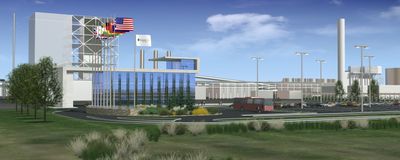Coal plant re-energized
Experimental FutureGen would reduce emissions

CHICAGO – FutureGen looked fated to become NeverGen when the Bush administration pulled the plug 18 months ago on the showcase clean-coal experiment slated for Mattoon, Ill. As of Friday, however, ProbablyGen would seem a more fitting nickname.
With a new president from Illinois and new national policies on global warming and energy development, federal officials and a consortium of energy companies said they were poised to restart FutureGen, a cutting-edge, commercial-scale power plant designed to burn dirty but abundant coal with little pollution.
If built, FutureGen would combine an array of high-tech solutions to tease energy from coal without fouling the atmosphere. The most critical test involves a plan to pump greenhouse gases deep into the Earth, where experts think they will harmlessly remain instead of percolating back to the surface.
“Developing this technology is critically important for reducing greenhouse gas emissions in the U.S. and around the world,” said Energy Secretary Steven Chu in committing more than $1 billion in federal stimulus funds to the project if new studies determine it remains economically feasible.
The project may cost more than $2 billion, with coal producers and users making up the difference.
The project, on the drawing boards for years, involves an unusual partnership of energy companies and the federal government and was at one time heartily embraced by former President George W. Bush.
Dozens of communities across the country bid for the chance to host FutureGen, which carried with it a promise of new jobs, investment and a slice of international attention.
Partnership officials settled on Mattoon in late 2007, but the Bush administration immediately signaled its displeasure and within weeks had yanked funding.
At the time, federal officials said costs were getting out of hand and the research money could be spent better elsewhere, but Sen. Dick Durbin, D-Ill., was among many skeptics who thought the project was being killed because it didn’t go to Bush’s home state of Texas.
On Friday, Durbin insisted the new administration had gone out of its way to avoid pressuring Chu into reviving FutureGen and gave him free rein to consider the project on its merits.
Despite increasing dependence on foreign oil, the U.S. sits on enormous coal reserves, and no state has more than Illinois. But the coal in Illinois is high in sulfur content, meaning it burns especially dirty. FutureGen technology, if it pans out, could open vast new opportunities for the Illinois coal industry.
Half the U.S. electricity supply comes from conventional coal-fired generating plants, which spew a stew of pollutants into the air. FutureGen would represent a radical departure.
Instead of burning coal, the plant would use a process called gasification to break the fuel into chemical components while releasing energy.
Environmentalists are split over the FutureGen concept, with some arguing that coal is so inherently dirty that nothing should be done to encourage its use.
Henry Henderson, Midwest program director of the Natural Resources Defense Council, acknowledged that there is no way to make a pollution-free coal plant but argued that FutureGen could represent a vast improvement.